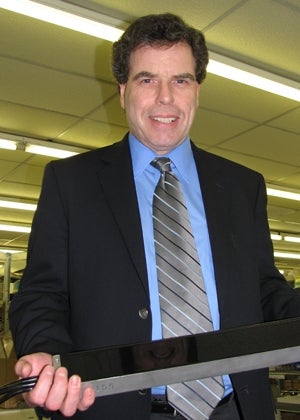Les Bowen knows a thing or two about bootstrapping. He founded Materials Systems Inc. back in 1991 to develop and manufacture sonar and ultrasound products that are used in a variety of applications, including by the U.S. Defense Department. He got the company going on his own dime, and now has 30 employees in a 20,000-square-foot office in Littleton. Here, he talks about how he managed to grow MSI from such humble beginnings and where he sees future growth.
How did you get the idea to start MSI?
I was working for a big company before, GTE Sylvania, and managing their technology and materials. GTE sold the Sylvania business to Siemens and they didn’t need us anymore. For me, that was an opportunity to do something that I had been thinking about for a while, and that was to start MSI.
What was it like to start a company during a recession?
The recession in 1991 was one of the advantages. I would go to the auctions and buy the equipment I needed. I would just use my home equity loan, because I couldn’t get financing because we didn’t make anything.
What are some of the applications for your products?
On the defense side, the Navy uses our products to find mines on the seabed, for example. They might use them on the front of weapons, torpedoes, so they can find their targets. Our products are also used for underwater surveying. On the commercial side, offshore exploration companies that do oil and gas drilling or laying cables use our technology.
When you founded the company, how did you handle financing and real estate and things like that?
The first thing I decided was what type of company I wanted to be. I knew I wanted to be a products company and I saw manufacturing at Sylvania and they’re excellent at it. So, I really understood what could be done in manufacturing to make things that people could really use. To get financing, you need to develop the products and invest in the technology. So, we needed to get the money and it took a long time for me to build the financing. The business isn’t one that lends itself to venture capital financing because the market takes too long to develop. Venture capitalists aren’t really that patient. They want a return on their investment. So, it was a bootstrap situation. As a result, we have no outside investors.
How has the business changed since 1991, or has it?
Well, it started off as a research and development company. Over the years we have had tens of millions of dollars invested by the department of defense through research contracts to get the technology where it is today. We’ve also seen investment by the private sector through our customers. In the first 10 years, it was pretty much all engineering and we were trying to figure out which markets were going to be best for us, whether it was going to be medical ultrasound, industrial ultrasound, or something else. We focused on the market that was going to be the best fit because you can’t be everywhere at once, and that was the sonar and ultrasound market. The biggest change was really the transition to manufacturing. For an engineering organization, making that type of transition is a big deal.
Was it difficult to remain disciplined through that process of narrowing your focus?
Fortunately, we had good advisors right at the beginning. Some of them were involved in the military over a long time, others were in finance. Maintaining discipline has been driven into us over a long time and now we’re self-driven. There’s really no place for a salesperson in this organization because it’s so technology-driven. We’re not selling bowling balls, here. We’re selling really high tech stuff and it’s always customized for every customer so you really have to have your arms around the technology.
What’s the greatest challenge facing the business today?
Having the resources to do what we want to do. Financing is very difficult. In this environment, the banks are very skittish, and we need to be able to invest in this business. Everything has to be engineered into the customer’s application for the first time. In order to grow, we need to be able to invest in the non-recurring portion to support the recurring portion. We’ve passed a critical point now that there’s enough repeat manufacturing that we can afford to throw money back up into manufacturing and engineering. Plus, the government contracts continue.
Les Bowen on how he financed his company MSI in Littleton:

